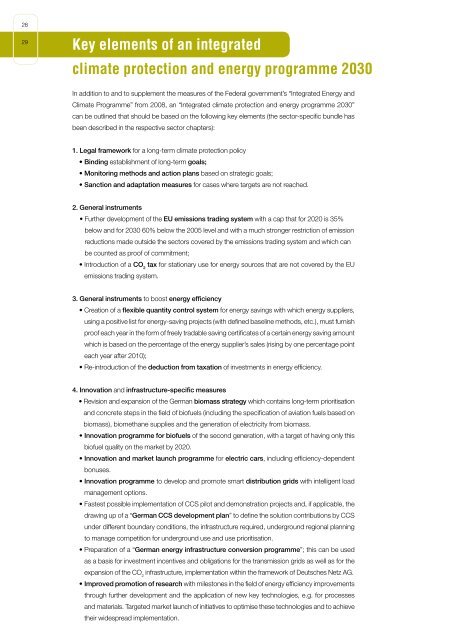Blueprint Germany - Öko-Institut eV
Blueprint Germany - Öko-Institut eV
Blueprint Germany - Öko-Institut eV
You also want an ePaper? Increase the reach of your titles
YUMPU automatically turns print PDFs into web optimized ePapers that Google loves.
28<br />
29<br />
Key elements of an integrated<br />
climate protection and energy programme 2030<br />
In addition to and to supplement the measures of the Federal government’s “Integrated Energy and<br />
Climate Programme” from 2008, an “Integrated climate protection and energy programme 2030”<br />
can be outlined that should be based on the following key elements (the sector-specific bundle has<br />
been described in the respective sector chapters):<br />
1. Legal framework for a long-term climate protection policy<br />
• Binding establishment of long-term goals;<br />
• Monitoring methods and action plans based on strategic goals;<br />
• Sanction and adaptation measures for cases where targets are not reached.<br />
2. General instruments<br />
• Further development of the EU emissions trading system with a cap that for 2020 is 35%<br />
below and for 2030 60% below the 2005 level and with a much stronger restriction of emission<br />
reductions made outside the sectors covered by the emissions trading system and which can<br />
be counted as proof of commitment;<br />
• Introduction of a CO tax for stationary use for energy sources that are not covered by the EU<br />
2<br />
emissions trading system.<br />
3. General instruments to boost energy efficiency<br />
• Creation of a flexible quantity control system for energy savings with which energy suppliers,<br />
using a positive list for energy-saving projects (with defined baseline methods, etc.), must furnish<br />
proof each year in the form of freely tradable saving certificates of a certain energy saving amount<br />
which is based on the percentage of the energy supplier’s sales (rising by one percentage point<br />
each year after 2010);<br />
• Re-introduction of the deduction from taxation of investments in energy efficiency.<br />
4. Innovation and infrastructure-specific measures<br />
• Revision and expansion of the German biomass strategy which contains long-term prioritisation<br />
and concrete steps in the field of biofuels (including the specification of aviation fuels based on<br />
biomass), biomethane supplies and the generation of electricity from biomass.<br />
• Innovation programme for biofuels of the second generation, with a target of having only this<br />
biofuel quality on the market by 2020.<br />
• Innovation and market launch programme for electric cars, including efficiency-dependent<br />
bonuses.<br />
• Innovation programme to develop and promote smart distribution grids with intelligent load<br />
management options.<br />
• Fastest possible implementation of CCS pilot and demonstration projects and, if applicable, the<br />
drawing up of a “German CCS development plan” to define the solution contributions by CCS<br />
under different boundary conditions, the infrastructure required, underground regional planning<br />
to manage competition for underground use and use prioritisation.<br />
• Preparation of a “German energy infrastructure conversion programme”; this can be used<br />
as a basis for investment incentives and obligations for the transmission grids as well as for the<br />
expansion of the CO infrastructure, implementation within the framework of Deutsches Netz AG.<br />
2<br />
• Improved promotion of research with milestones in the field of energy efficiency improvements<br />
through further development and the application of new key technologies, e.g. for processes<br />
and materials. Targeted market launch of initiatives to optimise these technologies and to achieve<br />
their widespread implementation.

















